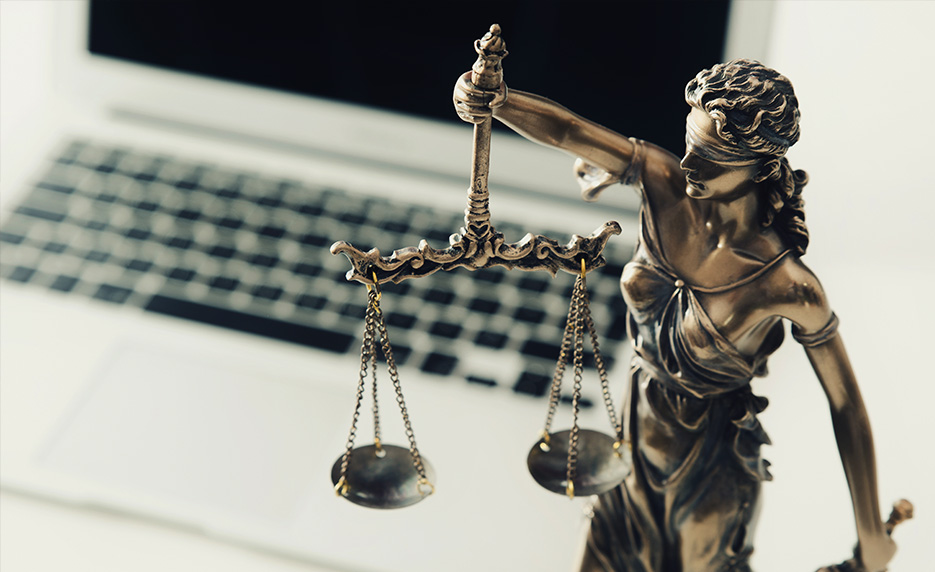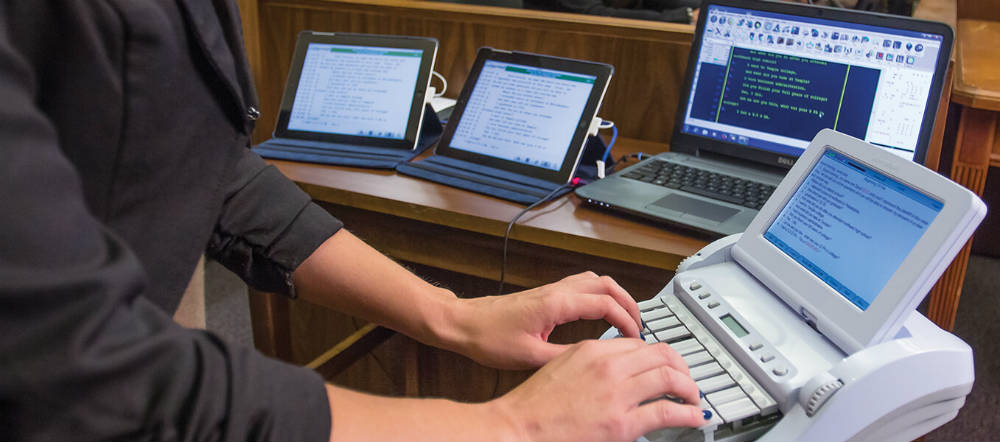How Court Reporting Functions: A Step-by-Step Guide to the Legal Process
Court reporting is a critical element of the lawful system. It involves an organized process that guarantees exact paperwork of proceedings. From prep work to the final delivery of transcripts, each step is essential. Recognizing exactly how stenotype reporter run offers understanding into the honesty of legal documents. The nuances of their job can exceptionally influence legal end results, triggering questions regarding the methods and modern technologies they use. What are the certain techniques that define this career?
The Duty of Court Reporters in the Legal System
Court press reporters play a necessary role in the legal system by offering exact and trustworthy transcripts of court process. Their work assurances that every talked word throughout hearings, tests, and depositions is documented, which is crucial for preserving a main record of occasions. This transcription is fundamental for charms, as it permits greater courts to review the procedures and identify if any kind of errors were made throughout the trial.
Additionally, stenotype reporter assist in maintaining the integrity of the lawful procedure by producing verbatim records that can be described by attorneys, courts, and various other parties associated with a case. They typically make use of specific equipment and software application to catch discussion with precision. Past the courtroom, their transcripts can work as crucial historical papers, supplying insight right into judicial process and the legal system's performance. Inevitably, court press reporters add considerably to openness and liability in lawful matters.
Preparing for a Court Reporting Session
Preparation is crucial for a successful court reporting session, as it ensures the precision and performance of the transcription procedure. Court reporters start by examining situation materials, including pleadings and witness listings, to acquaint themselves with the terminology and context. They also make specific that they have the needed devices, such as steno devices, notebooks, and back-up devices, on-line.
Prior to the session, communication with lawful groups is essential. Reporters frequently clarify any type of particular requests regarding format or preferred terminology. In addition, they might arrange to meet witnesses or lawyers to review the process and verify the routine. Showing up very early to set up the tools permits fixing possible technological concerns. In general, comprehensive prep work not just improves the reporter's self-confidence but likewise adds significantly to producing a exact and clear document of the legal process.

Catching the Document: Techniques and Equipment
Utilizing innovative methods and reputable equipment, stenotype reporter meticulously capture the spoken word during legal procedures. They utilize stenography, an approach including a specialized device that allows them to kind several sounds all at once, thereby recording discussion in genuine time. This maker, referred to as a steno key-board, is geared up with keys that represent syllables and words, making it possible for swift and accurate input.
In enhancement to stenography, stenotype reporter may use audio recording devices as additional tools. These devices act as backups, guaranteeing that no important details is shed throughout process. Some press reporters integrate software application that enhances their transcription efficiency, supplying features such as voice recognition and automated format.
Proper positioning and emphasis are paramount; reporters need to preserve attention on all audio speakers, recording subtleties and inflections that contribute to the record. Via a combination of skill and innovation, stenotype reporter copyright the stability of the lawful process by ensuring a comprehensive and exact record of occasions.
Recording the Process
Recording the process needs stenotype reporter to transform spoken dialogue into composed text with exceptional accuracy and speed. This procedure generally takes area instantly after the recording has been caught, using specialized software application that allows for seamless transcription. Stenotype reporter have to pay attention attentively to the audio, ensuring that every word, inflection, and time out is precisely represented in the transcript.
They typically depend on shorthand systems, personal transcription abilities, and advanced technology to facilitate this task. The atmosphere in which they work can be busy and often chaotic, as legal proceedings frequently entail numerous speakers and technological lingo. Stenotype reporter should additionally maintain concentration to capture subtleties in tone and context that might be necessary for the lawful record. Eventually, the accuracy of the transcription is critical, as it acts as a main file for future reference in lawful proceedings.
Modifying the records and evaluating
The procedure of evaluating and editing and enhancing the transcript is crucial for making certain accuracy in court reporting. Stenotype reporter frequently work together with attorneys to make clear any kind of uncertainties and verify the accuracy of the taped declarations. This collaboration is vital for keeping the honesty of the legal record.
Significance of Precision
Precision functions as the cornerstone of effective court reporting, as also small errors can significantly modify the definition of lawful procedures. The assessing and editing procedure is critical in making sure that records mirror the talked word with integrity. Stenotype reporter meticulously confirm names, technological terms, and lawful lingo to maintain accuracy. This attention her latest blog to information helps useful content protect against misconceptions that can affect situation end results. Accuracy cultivates count on amongst lawful professionals, customers, and the court, strengthening the honesty of the judicial system. Mistakes can lead to appeals or disagreements, making it crucial for reporters to improve their job thoroughly. Inevitably, the quest of precision not only enhances the reliability of the records yet also promotes the standards of the lawful occupation.
Partnership With Lawyers
Cooperation between court press reporters and lawyers is crucial during the assessing and editing stage of records manufacturing. This procedure ensures that the last file precisely mirrors the spoken word and abides by legal requirements. Lawyers frequently assess transcripts for particular terminology, context, and any type of potential mistakes that might influence the situation. Stenotype reporter count on lawyers' knowledge to clear up uncertain areas or highlight vital statements. Effective communication is key; attorneys may give comments or demand modifications, which stenotype reporter must deal with immediately. This partnership not just boosts the high go to this site quality of the transcript however also adds to a smoother lawful process. Ultimately, collaborative initiatives bring about a reliable and precise document, vital for future referrals and lawful procedures.
Delivering the Last Transcript to Customers
Upon completion of the transcription process, stenotype reporter diligently prepare the last record for distribution to their clients. This final records undergoes comprehensive proofreading to guarantee accuracy, as any kind of mistakes could greatly affect legal proceedings. Stenotype reporter layout the document according to the details needs stated by the customers or legal companies, including pagination, indexing, and any type of essential exhibits.

Ultimately, court reporters may give a cover letter summing up vital details and providing further aid if required. This extensive strategy guarantees that clients receive a polished, precise, and quickly accessible records, vital for their legal needs.
Often Asked Questions
What Credentials Are Needed to Come To Be a Stenotype Reporter?
To come to be a court reporter, people usually need a high college diploma, completion of a court reporting program, and certification or licensure, relying on state requirements. durham court reporting. Effectiveness in shorthand and technology is also important for success
Just how Lengthy Does It Require To Full Court Reporting Training?
Generally, completing court reporting training takes between 18 months to four years, depending on the program's intensity, the trainee's speed, and the particular demands of the territory in which they desire to exercise.

What Is the Average Income of a Stenotype Reporter?
The average wage of a court press reporter differs by area and experience, typically ranging from $45,000 to $100,000 yearly (durham court reporting). Elements such as expertise and demand can substantially affect their earnings in different areas
Are Court Reporters Required to Have Certification?
Stenotype reporter are commonly required to acquire accreditation, which ensures they have the required abilities and understanding for precise transcription. Qualification demands can differ by state or territory, showing professional standards within the legal community.
Can Court Reporters Job Remotely or Freelance?
Stenotype reporter can work from another location or freelance, supplying flexibility in their career. Numerous make use of modern technology to record procedures from numerous places, permitting varied opportunities in the legal field while keeping a work-life equilibrium.
Court reporters play a necessary duty in the lawful system by offering trusted and accurate records of court procedures. Additionally, court press reporters aid in maintaining the honesty of the lawful procedure by producing verbatim documents that can be referred to by attorneys, judges, and other events involved in a situation. Using innovative methods and dependable equipment, court reporters carefully capture the spoken word throughout legal proceedings. Court reporters must also preserve concentration to capture subtleties in tone and context that may be necessary for the lawful document. To become a court reporter, people normally need a high college diploma, conclusion of a court reporting program, and certification or licensure, depending on state demands.